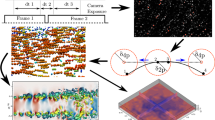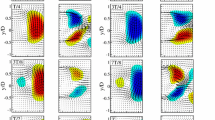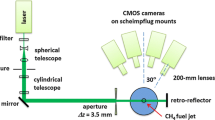Abstract
Particle imaging velocimetry (PIV) has been used extensively at NASA GRC over the last 15 years to build a benchmark data set of hot and cold jet flow measurements in an effort to understand acoustic noise sources in high-speed jets. Identifying the noise sources in high-speed jets is critical for ultimately modifying the nozzle hardware design/operation and therefore reducing the jet noise. Tomographic PIV (Tomo-PIV) is an innovative approach for acquiring and extracting velocity information across extended volumes of a flow field, enabling the computation of additional fluid mechanical properties not typically available using traditional PIV techniques. The objective of this work was to develop and implement the Tomo-PIV measurement capability and apply it in a large-scale outdoor test facility, where seeding multiple flow streams and operating in the presence of daylight presents formidable challenges. The newly developed Tomo-PIV measurement capability was applied in both a subsonic M 0.9 flow and an under-expanded M 1.4 heated jet flow field. Measurements were also obtained using traditional two-component (2C) PIV and stereo PIV in the M 0.9 flow field for comparison and validation of the Tomo-PIV results. In the case of the M 1.4 flow, only the 2C PIV was applied to allow a comparison with the Tomo-PIV measurement. The Tomo-PIV fields-of-view covered 180 × 180 × 10 mm, and the reconstruction domains were 3500 × 3500 × 200 voxels. These Tomo-PIV measurements yielded all three components of vorticity across entire planes for the first time in heated supersonic jet flows and provided the first full 3D reconstruction of the Mach disk and oblique shock intersections inside of the barrel shocks. Measuring all three components of vorticity across multiple planes in the flow, potentially reduces the number of measurement configurations (streamwise and cross-stream PIV) required to fully characterize the mixing-enhanced nozzle flows routinely studied in aeroacoustics research.



















Similar content being viewed by others
Abbreviations
- ω x , ω z :
-
x- and z-components of vorticity (1/s)
- D j :
-
Nozzle jet inside diameter (mm)
- M :
-
Mach number
- ppp :
-
Seed particle concentration (particles/pixel)
- r :
-
Radial coordinate from the jet centerline
- P 0 :
-
Stagnation pressure in the jet
- P ∞ :
-
Ambient pressure
- u′ :
-
rms variation in the u-component of the jet velocity (m/s)
- U :
-
Axial component of the jet velocity (m/s)
- U ideal :
-
Isentropic jet exit velocity (m/s)
- U j :
-
Centerline jet velocity at the exit plane (m/s)
- x M :
-
Distance from nozzle exit to Mach disk (mm)
- AAPL:
-
Aero-Acoustic Propulsion Lab
- ART:
-
Algebraic reconstruction technique
- LES:
-
Large eddy simulation
- MART:
-
Multiplicative algebraic reconstruction technique
- NPR:
-
Ratio of the stagnation pressure of the jet to the ambient pressure
- NTR:
-
Ratio of the stagnation temperature of the jet to the ambient temperature
- RANS:
-
Reynolds averaged Navier–Stokes solution
- rms:
-
Root mean square
- SART:
-
Simultaneous algebraic reconstruction technique
- SHJAR:
-
Small hot jet acoustic rig
- SMC:
-
Simple metal chevron
- SNR:
-
Signal-to-noise ratio
References
Alkislar B, Krothapalli A, Butler GW (2007) The effect of streamwise vortices on the aeroacoustics of a Mach 0.9 jet. J Fluid Mech 578:139–169
Avallone F, Ragni D, Schrijer FFJ, Scarano F, Cardone G (2014) Tomographic PIV investigation of roughness-induced transition in a hypersonic boundary layer. In: 17th International symposium on applications of laser techniques to fluid mechanics, Lisbon, Portugal
Bridges J, Wernet M (2010) Establishing consensus turbulence statistics for hot subsonic jets. In: AIAA-2010-3751, 16th AIAA/CEAS Aeroacoustics conference, Stockholm, Sweden, 7–9 June 2010
Bridges J, Wernet MP (2011) The NASA subsonic jet particle image velocimetry (PIV) dataset. NASA/TM—2011-216807. http://turbmodels.larc.nasa.gov/jetsubsonic_val.html
Bridges J, Wernet MP (2012) Validating large-eddy simulation for jet aeroacoustics. J Propuls Power 28(2):226–235. doi:10.2514/1.B34385
Buchner A-J, Buchmann NA, Kilany K, Atkinson C, Soria J (2012) Stereoscopic and tomographic PIV of a pitching plate. Exp Fluids 52:299–314
Decker AJ, Izen SH (1992) Three-dimensional computed tomography from interferometric measurements within a narrow cone of views. Appl Opt 31(36):7696–7706
Elsinga GE, van Oudheusden BW, Scarano F (2006a) Experimental assessment of tomographic-PIV accuracy. In: 13th International symposium on applications of laser techniques to fluid mechanics, Lisbon, Portugal
Elsinga GE, Scarano F, Wieneke B, van Oudheusden BW (2006b) Tomographic particle image velocimetry. Exp Fluids 41:933–947
Feng T, McGuirk JJ (2016) Measurements in the annular shear layer of high subsonic and under-expanded round jets. Exp Fluids 57:7
Hsieh J (2003) Computed tomography principles, design, artifacts, and recent advances, 2nd edn. SPIE, ISBN-13: 978-0470563533
Hu H, Saga T, Kobayashi T, Taniguchi N, Yasuki M (2001) Dual-plane stereoscopic particle image velocimetry: system setup and its application on a lobed jet mixing flow. Exp Fluids 31:277–293
Humble RA, Elsinga GE, Scarano F, van Oudheusden BW (2007) Instantaneous 3D flow organization of a shock wave/turbulent boundary layer interaction using tomographic PIV. In: AIAA-2007-4112, Proceedings of the 37th AIAA fluid dynamics conference and exhibit, Miami, Florida
Kaehler CJ, Kompenhans J (1999) Multiple plane stereo PIV: technical realization and fluid-mechanical significance. In: Proceedings of the 3rd international workshop on PIV, Santa Barbara, 16–18 September 1999
Labus TL, Symons EP (1972) Experimental investigation of an axisymmetric free jet with an initially uniform velocity profile. NASA TN-6783
Lau JC (1980) Laser velocimeter correlation measurements in subsonic and supersonic jets. J Sound Vib 70:85
Laurence JC (1956) Intensity, scale, and spectra of turbulence in mixing regions of free subsonic jet. NACA Report 1292
Lecordier B, Westerweel J (2003) EuroPIV synthetic image generator. In: Proceedings of the EUROPIV 2 workshop on particle image velocimetry, Zaragoza, Spain, March 31st–April 1st, pp 145–162
Melling A (1997) Tracer particles and seeding for particle image velocimetry. Meas Sci Technol 8:1406–1416
Orescanin MM, Austin JM (2010) Exhaust of underexpanded jets from finite reservoirs. J Propuls Power 26(4)744–753
Scarano F (2002) Iterative image deformation methods in PIV. Meas Sci Technol 13:R1–R19
Scarano F (2013) Tomographic PIV: principles and practice. Meas Sci Technol 24:1–27
Schrӧder A, Geisler R, Michaelis D (2007) Flow structures in a tripped turbulent boundary layer flow: an investigation using time-resolved tomographic PIV. In: 7th International symposium PIV, Rome, Italy
Seiner JM, Ukeiley LS, Jansen BJ (2005) Aero-performance efficient noise reduction for the F404-400 engine. In: AIAA-2005-3048, 11th AIAA/CEAS Aeroacoustics conference, 23–25 May 2005
Taylor JR (1982) An introduction to error analysis. University Science Books, Oxford University Press, Mill Valley, pp 142–144
Wernet MP (2005) Symmetric phase only filtering: a new paradigm for DPIV data processing. Meas Sci Technol 16:601–618
Wernet MP (2007) Temporally-resolved PIV for space–time correlations in both cold and hot jet flows. Meas Sci Technol 18:1387–1403
Wernet MP, Pline A (1993) Particle displacement tracking technique and Cramer–Rao lower bound error in centroid estimates from CCD imagery. Exp Fluids 15:295–307
Wernet JH, Wernet MP (1994) Stabilized alumina/ethanol colloidal dispersion for seeding high temperature air flows. In: Proceedings of the ASME symposium on laser anemometry: advances and applications, Lake Tahoe, NV, 19–23 June 1994
Wernet MP, Wroblewski AC, Locke RJ (2016) A dual-plane PIV study of turbulent heat transfer flows. NASA/TM-2016-219074
Wieneke B (2008) Volume self-calibration for 3D particle image velocimetry. Exp Fluids 45:549–556
Witze PO (1974) Centerline velocity decay of compressible free jets. AIAA J 12:417–418
Wroblewski A, Locke RJ, Wernet MP, Bridges J, (2011) Validating PIV measurements in supersonic jets using shadowgraph optical imaging. In: AIAA-2011-1163, 49th AIAA aerospace sciences meeting including the new horizons forum and aerospace exposition, Orlando, Florida
Acknowledgements
The author would like to thank NASA’s Fundamental Aeronautics’ Transformational Tools and Technologies Program for their support of this effort. The author also thanks Dr. Randy Locke, Dr. Adam Wroblewski and Garrett Clayo for their efforts in the setting up and implementation of the 2C PIV, SPIV and Tomo-PIV systems. The author thanks Dr. James Bridges for helpful discussions and for the use of the SHJAR facility. Lastly, the author thanks the staff at the AAPL for their dedication and support in making these tests possible.
Author information
Authors and Affiliations
Corresponding author
Rights and permissions
About this article
Cite this article
Wernet, M.P. Application of Tomo-PIV in a large-scale supersonic jet flow facility. Exp Fluids 57, 144 (2016). https://doi.org/10.1007/s00348-016-2228-3
Received:
Revised:
Accepted:
Published:
DOI: https://doi.org/10.1007/s00348-016-2228-3




